The world of technology is evolving faster than ever. Whether you’re a startup founder or an experienced developer, learning how to develop Oxzep7 software can open remarkable opportunities for you in efficiency, scalability, and innovation. Businesses today want products that combine both intelligent automation with human-centric design. This guide explains every essential step, from idea to deployment, showing how Oxzep7 can help both enterprises and all the developers to build future-ready digital solutions.
Understanding the Purpose of Oxzep7 Software
Modern organizations demand agility, efficiency, and innovation. And that’s exactly where develop Oxzep7 software plays a game-changing role. It enables teams to build a powerful, adaptable systems that evolve with business and new technology trends. When companies choose to develop Oxzep7 software, they gain access to a modular and intelligent framework that adjusts effortlessly to diverse requirements, from enterprise-level automation to small-scale applications.
Unlike outdated or rigid frameworks, develop Oxzep7 software focuses on modular architecture, real-time collaboration, and AI-assisted automation. This means developers can design, test, and deploy new features faster, while businesses can maintain the flexibility without compromising stability. The architecture encourages teams to break complex systems into smaller, more manageable modules, promoting scalability and long-term maintainability.
At its core, develop Oxzep7 software isn’t just about writing code but it’s about engineering smarter ecosystems. It aligns technical capabilities with organizational goals that allow developers and decision-makers to work in harmony. By combining data-driven insights, automated workflows, and adaptable APIs, it creates a seamless bridge between innovation and also execution.
Ultimately, to develop Oxzep7 software is to invest in a forward-thinking solution that enhances collaboration, improves speed to market, and supports sustainable digital transformation. It ensure that technology evolves alongside the business vision.
Key Objectives Before You Develop Oxzep7 Software
Before any coding begins, clear planning ensures success:
- Define your core goal. What problem does your product solve?
- Understand your audience. Are you targeting enterprises, small teams, or consumers?
- Set measurable outcomes. Example: reduce manual work by 30 % or speed up reporting by 50 %.
- Choose the right technology. Select frameworks that suit your scalability and integration needs.
- Plan for growth. Think beyond launch; prepare for updates and new features.
When teams define these early, they minimize rework and maximize ROI.
Building the Foundation: Core Architecture
A solid foundation determines long-term success. Here’s how professionals typically structure Oxzep7-based solutions:
Backend Layer
When you develop Oxzep7 software, the choice of backend technology plays a very crucial role in defining speed, scalability, and overall performance. Two of the most recommended stacks for building a clean and very high-performing API are Node.js with Express and Python with FastAPI.
If you choose to develop Oxzep7 software using Node.js + Express then you benefit from JavaScript’s asynchronous, event-driven nature which is perfect for handling multiple requests simultaneously without slowing down. Express provides a minimal but a very powerful framework that simplifies route handling, middleware management, and also API structure. This combination ensures that your Oxzep7-based applications run very smoothly even under heavy user loads.
Alternatively, you can develop Oxzep7 software with Python + FastAPI which are known for its exceptional speed and modern syntax. FastAPI supports automatic data validation, type hinting, and asynchronous operations that gives developers a cleaner, more efficient way to build APIs. Its design emphasizes clarity and maintainability, making it ideal for teams focused on reliability and rapid development.
Frontend Layer
When you develop Oxzep7 software then building a modern, responsive, and visually appealing interface is just as important as having a strong backend. Today’s users expect fast, dynamic, and seamless digital experiences. And that’s exactly what you can achieve by using React or Vue for the frontend, combined with Tailwind CSS for design efficiency.
When you develop Oxzep7 software with React, you leverage a component-based architecture that promotes reusability and scalability. Each UI element functions independently that allow developers to update or modify specific sections without affecting the entire system. This approach makes maintenance faster. And enhances the overall performance of Oxzep7-based applications.
Alternatively, choosing Vue when you develop Oxzep7 software offers a lightweight yet very powerful framework known for its simplicity and flexibility. Vue’s two-way data binding ensures that UI updates happen instantly, creating a smooth, interactive experience that adapts to user input in real time.
Integration Layer
When you develop Oxzep7 software, integration is one of the most critical aspects that determines how well your system performs in real-world environments. Modern software doesn’t operate in isolation — it needs to communicate seamlessly with other platforms such as CRM tools, analytics systems, and payment gateways. That’s why supporting APIs, webhooks, and plugins is essential when you develop Oxzep7 software for enterprise or commercial use.
By implementing robust APIs, developers can extend the functionality of Oxzep7 software and allow other applications to interact with it securely. This makes it easier to pull and push data between systems like Salesforce, HubSpot, or Zoho CRM, helping businesses manage customers, sales, and data from a unified interface. When you develop Oxzep7 software with well-documented RESTful APIs, integration becomes smoother and faster for both internal and third-party developers.
Security & Scalability
Table: Comparing Common Tech Choices When You Develop Oxzep7 Software
| Feature / Layer | Recommended Stack | Key Advantage | Example Use Case |
|---|---|---|---|
| Backend Framework | Node.js / Express | Fast, scalable REST API | Real-time dashboards |
| Alternative Backend | Python / FastAPI | Easy syntax, data analytics ready | ML-driven business systems |
| Database | PostgreSQL | Reliable, relational integrity | Enterprise data management |
| Frontend Framework | React / Next.js | SEO-friendly, dynamic UI | Web app portals |
| Containerization | Docker + Compose | Easy deployment anywhere | Cloud-native microservices |
| CI/CD Pipeline | GitHub Actions | Automated build & deploy | Continuous product delivery |
This comparison shows why Oxzep7 adapts easily across environments and why teams favor it for sustainable growth.
Step-by-Step Roadmap to Develop Oxzep7 Software
- Research and Requirement Gathering – Interview users, define goals, and identify the key modules.
- Architecture Planning – Choose monolithic or microservice style based on scale.
- UI/UX Design – Wireframe, prototype, and test user flows before coding.
- Backend Development – Build secure APIs and integrate your data models.
- Frontend Development – Create responsive layouts, dashboards, and forms.
- Testing and QA – Automate tests, perform manual validation, and fix bugs early.
- Deployment – Containerize, set up CI/CD, and push to staging before production.
- Monitoring and Maintenance – Track performance, errors, and user feedback continuously.
Each stage improves product reliability and ensures Oxzep7-based software remains consistent across updates.
Business Perspective: Why Companies Invest to Develop Oxzep7 Software
For enterprises, Oxzep7 represents more than a codebase — it’s a strategy for innovation. Companies benefit by:
- Reducing development time through reusable modules
- Achieving faster integration with existing systems
- Lowering maintenance costs via automated pipelines
- Enhancing data security and compliance readiness
- Empowering remote teams with collaborative architecture
Organizations that adopt this model see measurable ROI within months of deployment.
Technical Benefits and Innovations
From a developer’s viewpoint, Oxzep7 offers clean coding patterns and efficiency:
- Modular architecture improves code readability.
- Built-in scalability supports high-load scenarios.
- CI/CD pipelines simplify version control.
- API-first design ensures easy integration.
- Real-time analytics and event-driven systems improve decision-making.
These features give technical teams flexibility without sacrificing performance.
Comparing Traditional Development vs. Oxzep7 Approach
| Criteria | Traditional Software | Oxzep7-Based Software |
|---|---|---|
| Architecture | Monolithic | Modular / Microservices |
| Deployment Speed | Slow | Continuous CI/CD |
| Scalability | Limited | Cloud-ready & elastic |
| Maintenance Cost | High | Predictable & lower |
| Security Updates | Manual | Automated workflows |
| Integration Capability | Restricted | API-driven & flexible |
This shows why teams that develop Oxzep7 software gain faster delivery cycles and better scalability outcomes.
Pros and Cons of Using Oxzep7 Software
Pros
- Faster product development and iteration cycles
- Cross-platform compatibility
- Easier maintenance with modular structure
- Advanced analytics integration
- Strong developer community support
Cons
- Initial learning curve for beginners
- Requires clear documentation practices
- Slightly higher setup cost if advanced infrastructure is used
Despite minor drawbacks, its benefits far outweigh the challenges, making it a long-term strategic choice.
Ensuring Security and Compliance
Security is non-negotiable in today’s environment. When you develop Oxzep7 software, follow these steps:
- Encrypt data at rest and in transit.
- Use secure authentication and two-factor verification.
- Regularly update dependencies to prevent vulnerabilities.
- Implement logging, monitoring, and intrusion detection.
- Comply with data protection laws such as GDPR or HIPAA if applicable.
Strong compliance builds customer trust and prevents costly breaches.
Optimizing Performance and Scalability
Performance optimization starts early.
- Use caching to reduce database load.
- Compress static assets.
- Use load balancers for traffic distribution.
- Employ message queues (e.g., RabbitMQ) for background tasks.
- Continuously monitor response times and optimize slow endpoints.
By making optimization part of your culture, Oxzep7 projects stay fast and reliable as they scale.
Marketing Strategy After You Develop Oxzep7 Software
Technology alone doesn’t guarantee visibility. A smart marketing plan ensures your product reaches the right audience:
- Build an SEO-optimized landing page showcasing features.
- Publish technical blogs and case studies.
- Offer free trials or demos to collect feedback.
- Engage in developer communities for organic growth.
- Use targeted ads and partnerships to expand reach.
An integrated marketing plan transforms your software from an internal tool to a market-ready brand.
Cost and Resource Planning
Building Oxzep7 software can fit both small and large budgets depending on scope:
| Development Stage | Estimated Cost (USD) | Team Involved |
|---|---|---|
| Planning & Design | 2,000 – 5,000 | Business Analyst, Designer |
| Development (MVP) | 10,000 – 25,000 | Developers, QA Engineers |
| Deployment & QA | 3,000 – 7,000 | DevOps, Testers |
| Marketing & Launch | 2,000 – 6,000 | SEO, Marketing Specialists |
Efficient planning and agile management can significantly lower expenses without compromising quality.
Continuous Improvement and Future Trends
After release, continuous improvement ensures longevity:
- Gather user feedback regularly.
- Monitor system metrics.
- Schedule quarterly updates.
- Explore AI-driven automation, predictive analytics, and cross-platform integrations.
Emerging technologies such as generative AI, low-code tools, and cloud automation will further enhance Oxzep7’s capabilities.
FAQs
1. What makes Oxzep7 different from other software frameworks?
Its modular design, automation focus, and cross-platform scalability make it stand out.
2. Can small teams use Oxzep7 effectively?
Yes. Even small teams can adopt it gradually, scaling features as their user base grows.
3. Is it expensive to develop Oxzep7 software?
Not necessarily. Costs depend on feature scope, but open-source tools and cloud services make it affordable.
4. Does Oxzep7 support mobile integration?
Absolutely. You can extend it to mobile apps using APIs or hybrid frameworks like React Native.
5. How long does development take?
A simple MVP may take 2–3 months; complex enterprise systems may require 6–12 months.
Conclusion
Learning to develop Oxzep7 software is an investment in innovation. It merges the business vision with technical excellence that offers performance, scalability, and user satisfaction. By following structured planning, modern architecture, and ongoing optimization, you can build the software that grows with your audience and stays ahead of your competitors.
Oxzep7 isn’t just a framework but it’s a forward-thinking philosophy for digital success. Whether you’re a developer crafting efficient systems or a business leader seeking next-generation performance, Oxzep7 delivers the roadmap for long-term achievement.
Visit Worldpexa.com for more details



